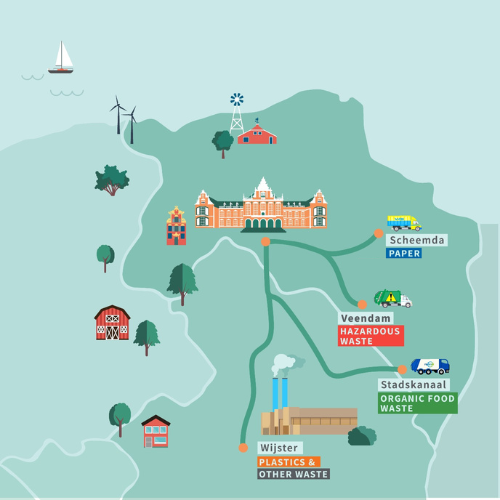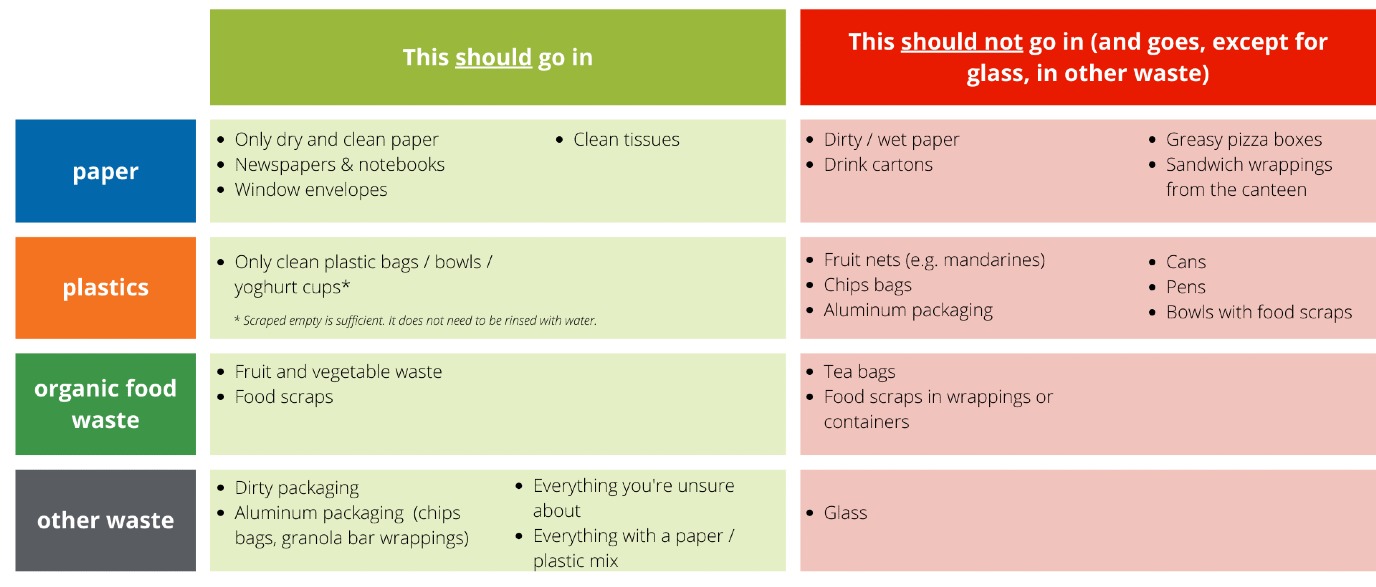Waste separation at the UG
The UG started separating waste at the source in March 2021 by introducing new waste bin islands. But, even today, not everyone is clear about how the system works. What goes in which bin? And why are the bins emptied into the same container when we collect the waste separately? This page tells you all about waste separation at the UG, from collection to processing.
How do we seperate waste at the UG?
At the UG, we separate our waste into five types of waste flows: paper, plastics, organic food waste and other waste. Hazardous waste produced in our laboratories is obviously collected separately.
All UG buildings have waste bin islands. They are a collection of waste bins of different colours designating the different types of waste. The bins are emptied regularly. Given that the layout of many buildings does not allow us to use a large enough waste disposal container to collect the waste flows separately, the bags are first emptied into the same large container. Once they have been taken to the collection point, they are separated again by waste flow. Plastic and residual waste are the exception. Rather than being separated, they are sent to the same company for processing. Read on to find out what happens with the different waste flows.
What goes where?
The table below shows what goes in which bin. Click on the tekst below the table to enlarge it.
What happens with our separated waste?
At the UG, we want to be as sustainable as possible about recycling and processing waste. That is why we only work with local companies to recycle or process our separated waste.

Paper
The paper we collect in the blue bins is recycled by PreZero in Scheemda. They wash the paper and break it down to pulp, which is subsequently pressed into new paper or used to manufacture toilet paper.
Plastics
Our plastic and residual waste goes to Attero in Wijster, which puts it through subsequent separation. Plastic can be recycled by melting and remoulding it into new products. Recycled plastic is suitable for the production of new bottles, among other uses.
Organic food waste
Renewi processes all our food and organic waste. This type of waste is used to produce compost, a natural plant fertiliser.
Other waste
Residual waste and plastic waste are subjected to subsequent separation by Attero.
Residual waste can be processed through incineration. Waste incineration generates energy, which is captured and reused. Some of the residue that is left after incineration can be used in road construction.
Cups (until recently)
The UG no longer uses disposable cups as of January 2024, students and employees bring their own. At most waste islands, the bins for cups have therefore been removed. However, the bins are being reused. For example, to collect reusable cups at an event, which are then cleaned.
What can you do?
Managing waste is teamwork. Here are a couple of useful tips for you:
-
Try to produce as little waste as possible. You might consider reusing packaging materials or other items you would otherwise throw out.
-
Be mindful and think about what goes where. You do not want to ‘pollute’ the waste flows. This would be the case when, for instance, there is too much plastic in the paper bin or if the paper is too greasy or covered in food residue. The recycling company would have to clean the recycled waste before being able to process it. This is a time-consuming and costly process. What is more, it can cause some of the waste to become unsuitable for recycling.
-
Make sure that plastic containers are clean when you put them in the plastic bin. They do not have to be spotless, but there should not be too much residue. If a container is impossible to clean, you should think of it as residual waste.
-
Help spread awareness of the importance of recycling.
At the UG, we have ambitious waste management targets: we want to reduce the amount of residual waste and we aim for all our residual waste to be suitable for recapturing in a circular process by 2026. The goal is to improve the University’s sustainability performance; this policy ties in with our values.
Why do we separate waste?
-
More recycling means less waste processing. This will reduce waste processing-related greenhouse gas emissions.
-
We lower the cost of waste processing: if we do a good job of separating waste, it is likely to be easier and less costly to process.
-
We save on raw materials: if we separate waste properly, it will be easier to reuse or recycle certain materials.
-
Separating waste raises awareness and inspires people to participate in the transition to a circular economy.
Frequently asked questions
Does our separated waste eventually end up in the same pile?
No, it does not. While it is true that the different types of waste are usually taken to the same central collection point, this does not mean that they are thrown back together. Rather, the separated waste is sorted by type and composition, and subsequently treated through recycling, reuse, incineration or composting, or sent to landfill, whichever method is most appropriate.
Does it make sense to collect organic waste separately?
Food and organic waste contain many biodegradable materials. That makes it suitable for composting to make fertiliser. By collecting organic waste separately, we make sure that this waste is composted instead of taken to landfill. This is better for the environment as it reduces the amount of waste released into the soil and lowers the required waste processing capacity.
Collecting organic waste separately also helps to reduce greenhouse gas emissions. Biodegradable waste that is taken to landfill is likely to rot and produce greenhouse gases. By separating and composting it rather than sending it to landfill, we help to reduce waste-related greenhouse gas emissions.
Did you know that, if you separate one type of waste, it should be food and organic waste? Organic waste mixed with residual waste is difficult to separate because it tends to be wet and sticky.
Is separating waste cost-effective?
Yes, it is. It is cheaper to separate waste than to mix all waste types together. Materials such as paper, glass, metal and textiles have value: unlocking this value by recycling them lowers the cost of collecting and processing waste. Collecting and recycling organic waste into compost and other biodegradable products is more cost-effective than incineration.
Does the environment actually benefit from waste separation?
Yes, it does. If we are better at separating waste, a larger share of it can be reused rather than being sent to landfill. This is more environmentally friendly as it reduces the amount of waste released into the soil and lowers the required waste processing capacity. Separating waste also helps to increase reuse and recycling, which reduces demand for raw materials.
Do you have questions about the waste policy? Let us know via communicatie.facilitair@rug.nl.

